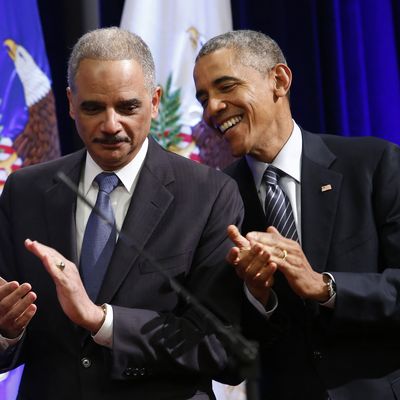
Barack Obama has often been accused of being insufficiently partisan — or at least insufficiently devoted to the particular interests of the Democratic Party. So, it’s interesting he’s signaling that he will make a new Democratic redistricting project headed up by former Attorney General Eric Holder “the main focus of his political activity once he leaves office.”
Holder’s group, dubbed the National Democratic Redistricting Committee, aims at reversing or at least mitigating the Republican state-level advantage the GOP won in 2010. Republicans used that edge to protect incumbents and open up new opportunities via the decennial reapportionment and redistricting process.
At the moment, Republicans hold “trifectas” — the unified control of the governorship and both legislative branches that gives them total control over redistricting for the U.S. House and state legislatures — in 23 states. There are only seven Democratic “trifectas,” with partisan control being divided in the other 20 states. Democrats can make some inroads among legislatures this November if the national ticket is doing well. Unfortunately for them, they already hold eight of the 12 governorship up this year. Two more are up in 2017. Then come the all-important 2018 elections, with most legislators and 36 governorships (including 24 controlled by Republicans) at stake. And then the parties will have one more bite at the apple in 2020 before the deal goes down for another decade.
Without question, Democrats are playing catch-up on redistricting. The new NDRC is designed to take a big leap:
The NDRC plans to hold regular meetings of Democratic groups and allies, building collaborative strategies on recruitment, ad spending, get out the vote and other efforts to maximize resources and impact. House campaigns would then work with state senate and assembly campaigns, unions, progressive organizations and others in high opportunity areas, hoping to push up their numbers as much as possible ahead of the 2020 census.
Democrats are fortunate the final big round of state elections before redistricting are in a presidential year, when turnout patterns are relatively favorable. Last time around, in 2010, a big Republican midterm-turnout advantage emerged, which recurred in 2014; it is mostly caused by the close current alignment of the two parties with groups that do (older white people) and do not (young and minority voters) tend to participate proportionately in non-presidential elections.
Trouble is, 2018 is probably the single most crucial election in determining the balance of power in the states going into redistricting. And aside from the pro-Republican midterm-turnout pattern, the odds are that we will be halfway through a third consecutive Democratic presidential term. This is typically a bad year for the White House party. And assuming the GOP comes out of a post-Trump “struggle for the soul of the party” intact, 2018 could be the “revenge” year for Republican base voters furious about one of its maximum demon figures succeeding the other as president.
Holder and Obama are exactly right: If Democrats want to go into redistricting at something other than a serious disadvantage, they’d better get cooking right now.






























